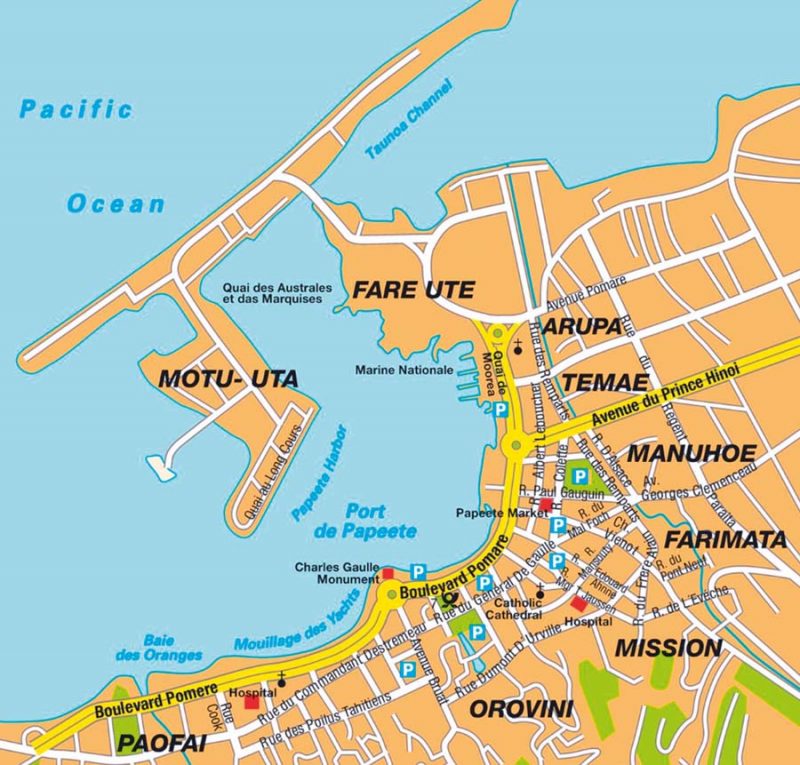
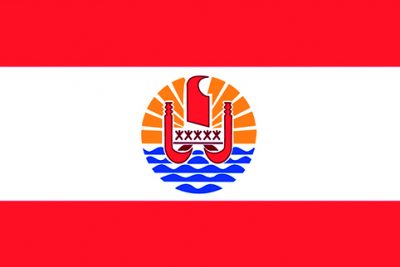
![]() Papeete is the capital of Tahiti, the largest island in French Polynesia, which has been an overseas territory of France since 1958. French Polynesia consists of around 130 tropical islands scattered over 1.5 million square miles of the Central South Pacific. The islands are in six groups: the Windward Group including Tahiti, the Leeward Group, the Tuamotu Group, the Gambier Group, the Austral Group and the Marquesas Islands. The total land area of the six groups is 1,544 square miles, with Tahiti being 403 square miles in area and 28 miles across at its widest point. Tahiti is shaped like a ‘Figure 8’ with the largest western part of Tahiti Nui (Big Island) and the eastern peninsula of Tahiti Iti (Small Island). The island has beautiful white sandy beaches, lush rainforests, many waterfalls including the Fautaua Falls near Papeete, and two extinct volcanoes. The south eastern part of Tahiti Nui remains remote and isolated today, with only a narrow ribbon road running around parts of the coast of the island.
Papeete is the capital of Tahiti, the largest island in French Polynesia, which has been an overseas territory of France since 1958. French Polynesia consists of around 130 tropical islands scattered over 1.5 million square miles of the Central South Pacific. The islands are in six groups: the Windward Group including Tahiti, the Leeward Group, the Tuamotu Group, the Gambier Group, the Austral Group and the Marquesas Islands. The total land area of the six groups is 1,544 square miles, with Tahiti being 403 square miles in area and 28 miles across at its widest point. Tahiti is shaped like a ‘Figure 8’ with the largest western part of Tahiti Nui (Big Island) and the eastern peninsula of Tahiti Iti (Small Island). The island has beautiful white sandy beaches, lush rainforests, many waterfalls including the Fautaua Falls near Papeete, and two extinct volcanoes. The south eastern part of Tahiti Nui remains remote and isolated today, with only a narrow ribbon road running around parts of the coast of the island.
The even more beautiful island of Moorea with high strange shaped extinct volcanoes lies fifteen miles due west of Papeete. Tahiti was originally settled by Polynesians from 300 BC, who explored the two islands and gave the name of Taravau to the short connecting strip between the two parts of the island of Tahiti. The population of Tahiti is today three quarters Polynesian, with the rest being Chinese, mixed race, and French. Capt. James Cook arrived on Tahiti in 1769 to find the Polynesians sailing big outrigger canoes of thirty metres in length, which could transport whole families and their domestic animals. The practice of human sacrifice among the Polynesians was repugnant to the British seafarers of Capt. James Cook. The early European explorers usually rounded Cape Horn and then sailed with a following wind to the ‘big’ island of Tahiti, whose longitude was known and could be reached with some accuracy by the new chronometers of that period.
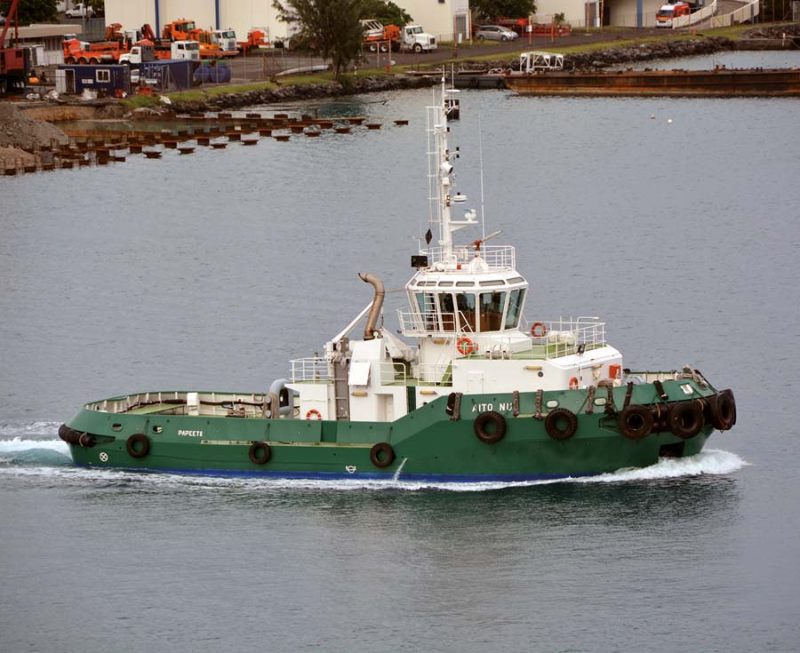
French Polynesia thus comprises several scattered and widely spread out groups of islands lying two thirds of the way between Panama and New Zealand. The Windward Islands of Tahiti and Moorea, and the Leeward Islands (Iles Sous le Vent) lying 160 kilometres to NW of Tahiti, form the main Society Islands group, along with the Tuamotu Archipelago of eighty atolls, the Marquesas Archipelago lying 1,450 kilometres to north east of Tahiti, and the Gambier Islands lying 1,600 kilometres to south east of Tahiti. In total, there are 35 islands and 83 atolls in French Polynesia, of which 76 are inhabited. The total land area of French Polynesia of 1,544 square miles is not much compared to the 64 million square miles of the Pacific Ocean. The highest point on Tahiti is Mount Orahena, but most of the population of 78,000 live in Papeete. The native population when the French and British first arrived was actually higher at 100,000, but disease carried by the white man soon decimated this figure to only six thousand.
The main port of Port Autonome de Papeete on Tahiti is where the CMA CGM and Marfret container and multi-purpose vessels call on their service to Noumea on New Caledonia and onward to Australian and New Zealand ports. The last Bank Line vessels called here in September 2009 and used the same berths as the CMA CGM and chartered Marfret vessels use today to load copra, sugar cane, mother of pearl, coffee and vanilla. The Passenger Terminal (Gare Maritime) is used by 1.6 million inter-island passengers from Moorea (15 miles across the Sea of the Moon), Bora Bora, Tahaa and Raiatea, and by fifteen inter-island ferries including the car ferries and high speed catamarans of Aremiti Ferries. There are around ten thousand international cruise passengers annually. A total of two million tonnes of cargo and 70,000 TEU of containers are handled annually at the cargo port zone of Motu Uta. Papeete lies at the north west corner of Tahiti Nui, which has a narrow connection to the smaller island of Tahiti Iti. Tahiti is a gorgeous cruise and holiday destination with white sandy beaches, turquoise lagoons, and many high vertical waterfalls.
History Of Papeete Port
British and French seafarers arriving at the harbour of Papeete in the early 18th century through a gap in the ribbon barrier reefs of the island, noted that the island shone like a ‘green emerald’ and the flag of ‘O-Taiti’ flew over the harbour of Queen Island, as it was then called. Coconuts, breadfruits and the extensive fishing were the chief means of support of that time, with the port of Papeete given its name from the Polynesian word meaning ‘water basket’ because of the richness of the fishing. The natural channel into the port with a reef to port and the small island of To’ata to starboard led into Nanuti Bay, which today has a compact port and the population of Papeete living on its eastern shore. British missionary William Crook became the first European to settle on Tahiti in 1818, with Queen Pomare IV ensconced on the island throne at Papeete at this time.
Tahiti became a French and British Protectorate between 1843 and 1880, when the Tahitian King ceded it to France. However, a confrontation had taken place between the French and the British earlier in 1843 when Admiral Dupetit-Thouars had acted beyond his instructions and annexed Tahiti for France. The British consul was imprisoned with all of the British residents enraged. A sensible compromise led Tahiti becoming not a French possession for the time being but a protectorate of both nations. The islands were governed by France under the decree of 1885 until 1946 when French Polynesia became an Overseas Territory administered from Papeete. A new constitution was agreed in 1977 whereby France kept responsibility for defence, foreign affairs, and financial and judicial matters, but political and commercial powers were introduced for local people. The French Polynesia economic zone was extended at the same time to 200 nautical miles from the Tahiti coastline.
The number of sailing vessels arriving at Papeete in the 1840s began to increase, with numerous American whaling ships, one carrying Herman Melville (later to write ‘Moby Dick’ and be imprisoned on Tahiti in 1842), and schooners trading in copra, vanilla and mother of pearl. Wooden landing stages were built, which were replaced by a single wharf built of iron and masonry. The writer Robert Louis Stevenson arrived in Tahiti in 1888, and the artist Paul Gauguin arrived three years later and stayed for the rest of his life, except for a brief two year sojourn back to France. A severe fire destroyed half of the Port of Papeete in 1884, leading to the French Government prohibiting the use of traditional building materials. Damage from typhoons and cyclones in 1906 and from a bombardment by German warships in 1914 with a French warship sunk in the harbour was also significant.
The first cargo wharf of any size was built at the end of the 19th century and located in downtown Papeete. The six island groups were connected by small schooners and iron hulled steamers, carrying goods and passengers. The nature of the port changed in 1923 with the arrival of regular passenger and cargo steamers of Messageries Maritimes of France. The French ships ran regular services either through the Panama Canal or from Australia, and a larger wharf was built in 1928 to accommodate two of these bigger ships at any one time.
The slipway of Fare Uta in the north eastern part of the port was built in 1950 in parallel with the old quay, and an oil bunkering wharf was completed in 1957. Cargo was still unloaded by derricks of the ships and piled on the open quays, to be carted away by the local merchants. During the late 1950s, the port installations received severe criticism from shippers due to the lack of space, warehousing and cranage, and the big increase of trade and ships calling at the port.
This all changed in 1962, when the French Government signalled the start of nuclear bomb testing on Mururoa reef, 1,500 kilometres from Tahiti and well in the eastern part of French Polynesia, or the ‘Centre of Experimentation of the Pacifique’ as they quaintly called it. The sinking of the Greenpeace protest vessel Rainbow Warrior in New Zealand by placing limpet mines on her hull by French Government saboteurs, and two days of rioting in the Port of Papeete in 1995 when forty people were injured and the international airport was badly damaged, were two examples of the fears of the spread of nuclear radiation through the sea and atmosphere towards Tahiti. The final French Government nuclear tests ended in 1995 amid huge international and local protests.
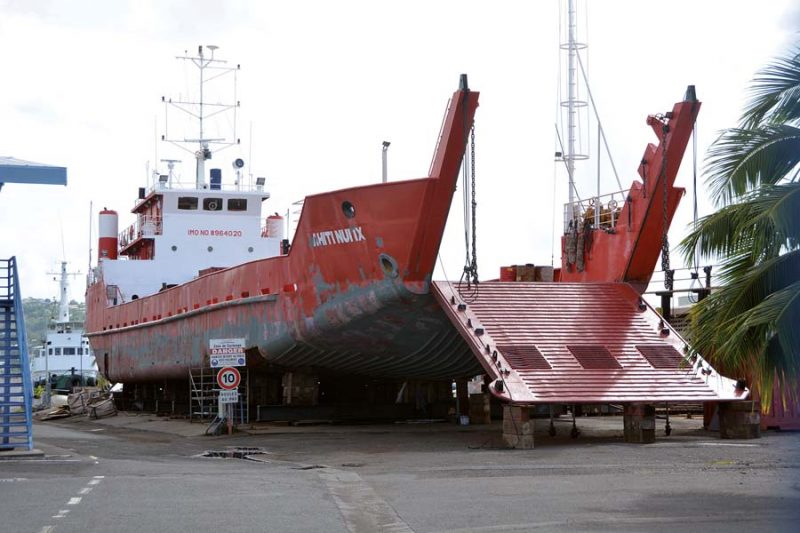
Thyroid cancers probably killed as many as 239 Polynesians living within one thousand miles of Mururoa, and especially those living within a short distance away, according to French medical research body Association des Veterans des Essais Nucleaires. France conducted 210 nuclear bomb tests between 13th February 1960 and 27th July 1996, with the first seventeen in Algeria, four in the atmosphere, and thirteen underground, with the rest on Mururoa atoll. Radiation measured in the Gambier Islands after two tests was over five times the permitted annual dose, while after three tests set off within a very short period, radiation equivalent to the entire permitted annual dose was measured in Tahiti.
A big, well equipped French naval base was built with a large floating dock in Papeete harbour, and the harbour was extended by reclaiming land from the sea by the construction of a seawall of length 2.2 kilometres and five metres in height. The backfilling of the small Motu Uta island inside the harbour allowed the present two long cargo handling wharves and other quays of total length of 1,100 metres, open areas of 50,000 square metres, and storage areas of 22,500 square metres. The total cost of the Motu Uta project was 1.086 billion Central Pacific Francs, of which 931 million was paid by the French State, 55 million by the French Polynesia administration, and 100 million by the Port Authority of Papeete. The project was declared complete when opened on 29th July 1966 by General Billotte, Minister for Overseas Departments and Territories of France.
The Port Autonome de Papeete was established on 5th January 1962 by French Government decree, later amended by another governmental decree on 21st November 1985, and given more autonomy on 22nd December 1997 by yet another governmental decree. The Board of Directors is headed by a Chairman, a French High Commissioner, and a French Polynesian Minister, with the port given French ‘EPIC’ status or ‘Establissement Public a Caractere Industriale et Commerciale’. The Port Authority of Papeete now enjoys full financial autonomy from the French State, with receipts from cargo worked, mooring and berthing tolls, Customs tax tolls, and port entry tariffs. The toll taxes are fixed by the deliberations of the Assembly of French Polynesia however. The maritime domain of the Port Autonome de Papeete extends to 2,250 hectares along the barrier reef, with a port water area of 534 hectares and a terrestrial domain of eighty hectares of port facilities in front of the town of Papeete.
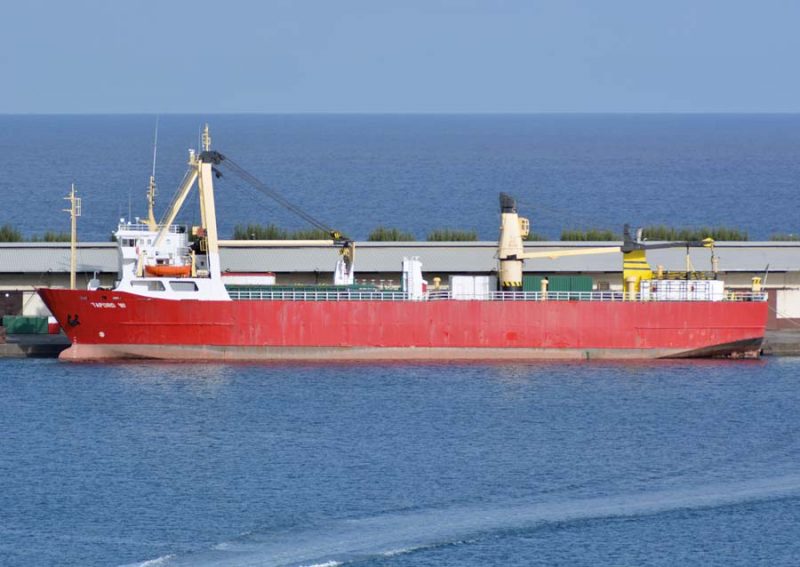
The Port Autonome de Papeete also had jurisdiction over the Port of Valare in Moorea, with island passenger craft and yachts calling, and the Marina Taina, located on the west coast of Tahiti in the commune of Punaaula. There are also the other beautiful nearby Windward Islands of Mehetia, Maiao and Tetiaroa, also covered in tall palm trees as on Tahiti and Moorea. The Port Autonome de Papeete today is a major calling port for large container and multi-purpose vessels engaged in South Pacific transits, with the main exports being sugar cane, mother of pearl, coffee, vanilla, and fish. Tahiti today has half of the population of the entire French Polynesian six groups of islands, and their chief means of support today is tourism, followed by the copra, phosphates, fishing and other light industries.
Port Of Papeete Trade
The Port Autonome de Papeete is reached through a gap in the barrier reef protected by a breakwater with the main channel being 12.0 metres deep. The annual total cargo trade is two million tonnes, made up of half this total of foreign trade dry bulk and containers in container ships of up 2,200 TEU capacity, and half being the local cabotage trade to the other five French Polynesia groups of islands as well as a large amount of fish. There are four cruise ship berths, three quays for cargo handling, six quays for inter-island traffic, and the Moorea quay for ferries and catamarans to the nearby islands. There are three oil jetties, and three quays of length 240 metres for the local fishing fleet to the north east of the Fare ‘Ute part of the port. A large fleet of ninety tuna fishing vessels berth here at these three quays. The Port Autonome de Papeete manages two marinas, one at Moorea and one at Papeete, each with capacity for fifty yachts.
The cruise ships are berthed at four berths on two jetties (North and South), each jetty being of 35.0 metres width with an alongside depth of 12.0 metres.The port berths are as follows :-
| Length |
Alongside Depth (m) |
|
| N. Cruise Berth1 | 200.0 | 12.0 |
| N. Cruise Berth 2 | 200.0 | 12.0 |
| S. Cruise Berth 1 | 200.0 | 12.0 |
| S. Cruise Berth 2 | 200.0 | 12.0 |
| Mota Uta quay | 453.0 | 12.0 |
| Mota Uta oil berth | 130.0 | 10.0 |
| Fare Ute oil berth | 130.0 | 10.0 |
| Inter-Island berth | 120.0 | 6.0 |
| Moorea wharf | 100.0 | 6.0 |
| Cabotage wharves (6) | 980.0 | 6.0 |
| Fish wharves (3) | 240.0 | (Total) 6.0 |
Containers are stored on 140,000 square metres of land next to the Mota Uta cargo quay, and there is a car storage building located next to the entry point of the Customs Area on four levels with parking for 500 cars. A storage area of 3,700 square metres is adjacent to this building and is used for the storage of project and heavy lift cargo.
The Port Autonome de Papeete celebrated forty years of operation on 5th January 2002, and this was followed by a visit by the French President, Jacques Chirac, on 26th July 2003 along with his wife. He opened the North cruise ships berths in the presence of Madame Beatrice Chansin, the Chief Operating Officer of the port, and other French Polynesian dignitaries. During the forty years, more than 2.5 billion Central Pacific Francs had been invested in the port, which now had the facilities to become a major cruise ship port, with shorter cruises also to the five neighbouring island groups. The French President affixed a plaque on a stone to celebrate this milestone, and during his speech he paid tribute to the support of the Government of French Polynesia for the economic progress made by the country.
Cruise ship lines calling at Papeete include Carnival Cruise Lines, Royal Caribbean International (RCI), Regent Seven Seas Cruises, Oceania Cruises, Princess Cruises, Celebrity Cruises and many other lines. The cruise vessels of Windstar Cruises, Paul Gauguin of Paul Gauguin Cruises, and Marina Cruises operate permanently on cruises from Papeete and Moorea to the Marquesas and other South Pacific islands.

Trans Pacific Trades
CMA-CGM
The joint CMA-CGM and Marfret service today operates from Rotterdam, Tilbury, Dunkirk, Le Havre, New York, Savannah, Kingston (Jamaica) and Cartagena to Panama, Papeete, Noumea, Sydney (NSW), Melbourne, Tauranga, Napier, Lyttelton, Manzanillo (Mexico), Savannah, Philadelphia and North European ports. A fortnightly South Pacific service is maintained by six vessels, with a regular river service to Paris and Rouen to bring South Pacific and other cargo from Le Havre to the French capital. Five of these vessels are owned by CMA CGM, and one vessel by Marfret. The Marfret vessel on the South Pacific service via Panama is Rossini of 33,900 dwt and 2,478 TEU capacity with four hundred reefer plugs. She was built in 2005 by Aker at Wismar as Julia Schulte for charter work with a length of 208 metres and beam of 30 metres and with three deck cranes of 45 tonne capacity, and was taken on charter by Marfret in February 2014 and renamed as Rossini. CMA CGM operates the other five similar vessels of CMA CGM Auckland, CMA CGM L’Etoile, CMA CGM Lavender, CMA CGM Utrillo and CMA CGM Mozart of between 2,500 to 2,850 TEU capacity. The container services of Australian National Line were purchased in 1998 for A$10 million together with debts of A$50 million, as ANL was the leading carrier between Australia/New Zealand and South East Asia, and there were ten services linking the two areas at that time. This has continued for the last two decades, with big ANL container ships such as the ungeared sisters ANL Barwon and ANL Barega of 46,000 dwt arriving regularly at Papeete, along with chartered ships.
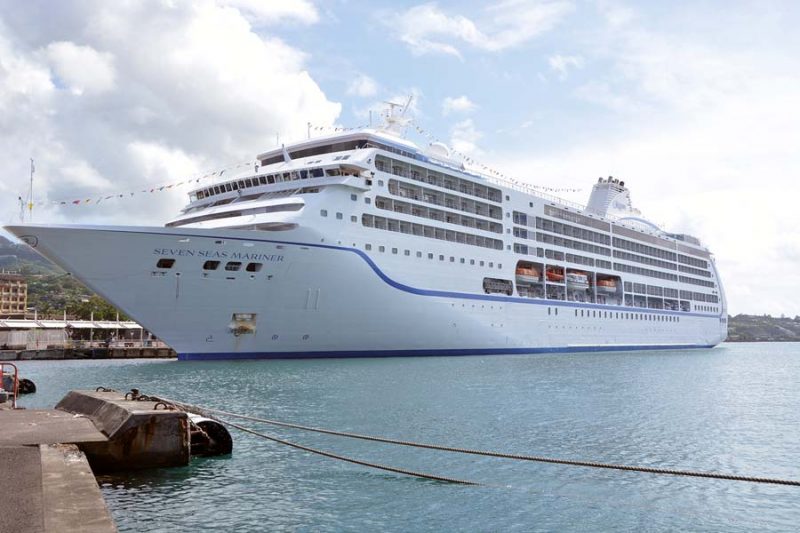
Swire Shipping
John Samuel Swire arrived in Hong Kong on 28th November 1866 and set up the China Navigation Co. Ltd. in 1872 with a capital of £360,000. This company has grown into a worldwide shipping organisation with offices in many countries over the last 145 years. The Pacific islands trade of the company to New Guinea, the Solomons, Fiji, Tonga and Tahiti has been one of the great staple trades of the company since the 1950s. Side loading conversions for the New Guinea Pacific Line in the 1960s enabled unit load palletised cargoes to be handled through side ports by shipborne fork lift trucks, This innovation opened up a range of New Guinea and Pacific islands trades, as most of these ports had no cargo handling cranes or equipment. Vessels with ‘Chief’ names began to appear in the Swire loading lists for the Pacific islands e.g. Coral Chief, Island Chief, Papuan Chief and New Guinea Chief.
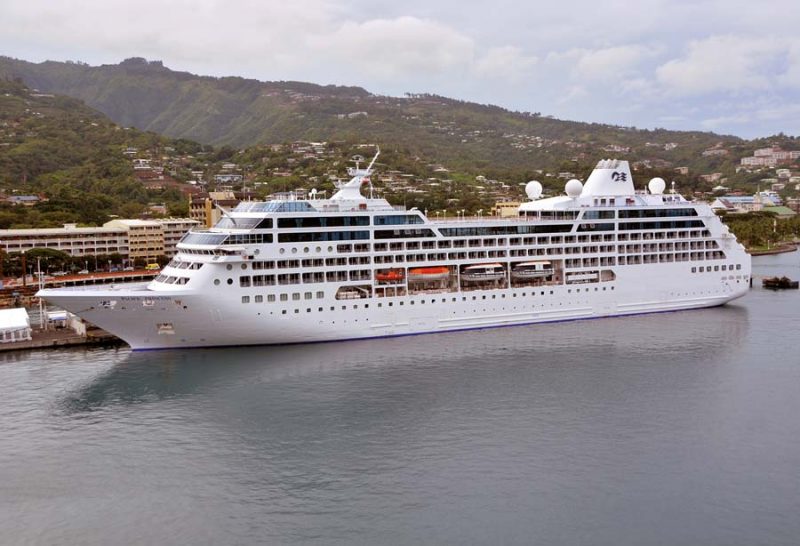
In 1980, The China Navigation Co. Ltd. and Chief Container Services (CCS) had a dedicated fleet of vessels with ‘Chief’ names e.g. Papuan Chief and Coral Chief of 6,973 grt delivered by the Miho Zoshensho yard at Shimizu in Japan for the Pacific Islands trades. A new class of four multi-purpose vessels of 22,832 dwt with a large container capacity of 1,617 dwt were delivered in 2015 for the service from China (7 ports), Taiwan (2 ports), Japan (4 ports), Busan, Ho Chi Minh City, Jakarta, Manila, Papua New Guinea, New Caledonia, Noumea, Nauru, Fiji (Suva and Lautoka), Majuro (Marshall Islands), Tarawa (Kiribati), Pago Pago (American Samoa), Apia (Samoa), Nuku’alofa (Tonga), Vanuatu (Port Vila and Santo) and Papeete.
Coral Chief, Papuan Chief, Highland Chief and New Guinea Chief were delivered by the Zheijiang Ouhun yard in China to a design by Neptun Ship Design as a five hold, five hatch class. They have three pedestal cranes each of 60 tonnes capacity, with the forward pair able to operate in tandem to give a heavy lift capability of 120 tonnes. The hatches are strengthened to carry containers, with number one fo’c’stle hatch able to take ninety stacked containers. A Wartsila two stroke low speed diesel generating 10,000 bhp at 105 revolutions per minute gives a service speed of 15.5 knots, and a very low fuel consumption gives a range of 18,000 nautical miles and is ideal for the long distances covered in the Pacific to Papeete.
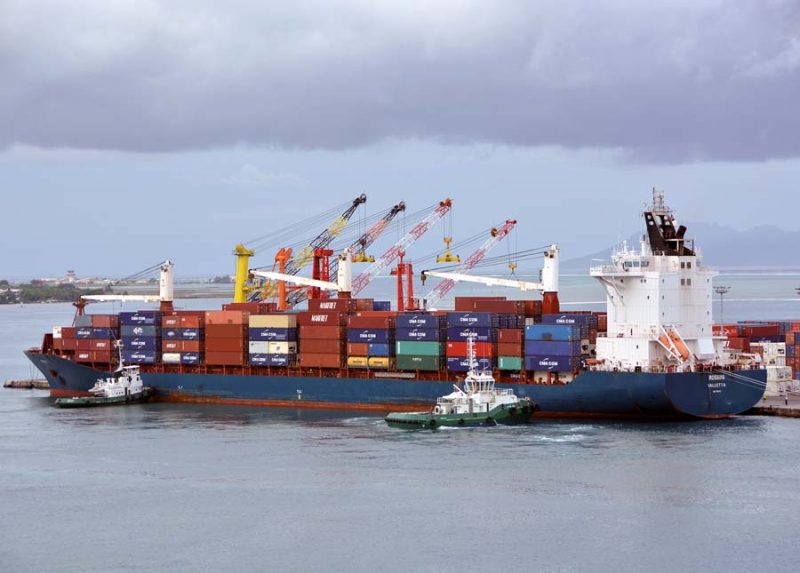
Polynesia Line was set up jointly by Swire Shipping (Polynesia) Ltd. and Marine Containerships of San Francisco in 1973. The new container ship Polynesia of 8,083 grt operated to Tahiti and Western Samoa from San Francisco and Los Angeles. She has been replaced by a new Polynesia 16,137/2010 running in tandem with Cap Avatele or Cap Taputapu, both 9,932/2014 and chartered from Hamburg Sud, to Papeete on a fortnightly service from San Francisco to Papeete, Pago Pago (American Samoa), Apia (Samoa) and Nuku’alofa (Tonga). She then returns to Los Angeles, with other American ports called at if sufficient inducement e.g. Seattle, Honolulu, Long Beach, San Diego and ports in Mexico. Cap Taputapu is named after a headland on Tutuila Island in American Samoa. Container, unitised, pallet, breakbulk and heavy lift project cargoes are carried, with freight handling agencies throughout the Pacific ports sourcing cargo, and with Polynesia Line managed from San Mateo (California).
Seatrade
Seatrade of Groningen offer a reefer service with fixed sailings every ten days from Europe to Tahiti, New Caledonia, New Zealand, Peru, the U.S. Eastern Seaboard and return to Europe. The port rotation of their Meridian service is Rotterdam, Dunkirk, Le Havre, Papeete, Noumea, Nelson, Napier, Tauranga, Callao, Pisco, Philadelphia, Zeebrugge, Tilbury and Rotterdam. Owned ships include Seatrade Blue (christened at Dunkirk on 31st March 2017), Seatrade Red, Seatrade White and Seatrade Orange, as well as chartered ships from the big German Schulte and ‘Nord’ Oldendorff fleets of Cyprus. South bound cargoes include containers, general cargo, machinery, yachts and boats, while north bound cargoes include apples, kiwi fruits, frozen and dry cargoes and yachts from New Zealand, as well as mangoes, avocados, blueberries, citrus, grapes, onions, sweet potatoes, asparagus and frozen fish from Peru. Papeete is reached in 23 days from Europe, New Caledonia in 30 days, and New Zealand in 33 days, with the full rotation back to Europe taking two months and ten days.
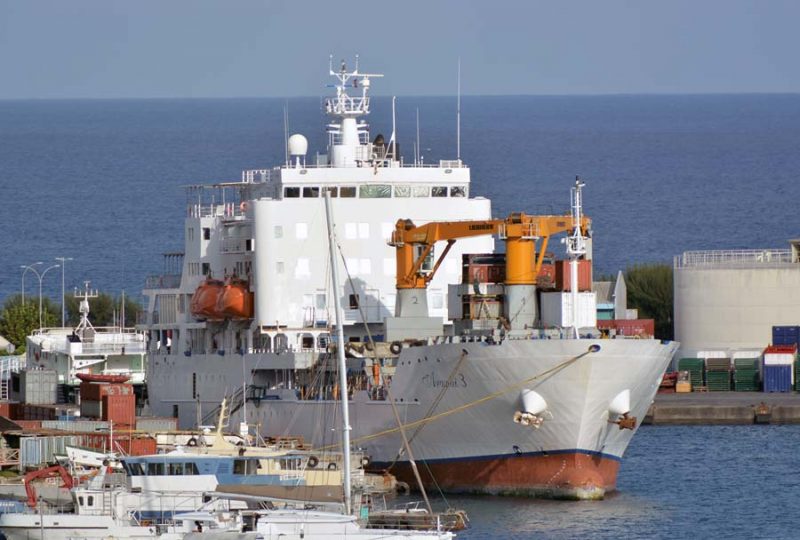
Inter-Island Trades
Marquesas Group
Compagnie Polynesienne de Transport Maritime (CPTM) is a third generation shipping company founded in 1954 in Papeete by the patriarch of the Wong family of Tahiti, first as Wing Man Hing and later as C.P.T.M. Originally, it served the Tuamotu and Gambier Islands archipelagos with small traders such as Kekanui 400/54 and Aranui 1,540/67, which was converted in 1984 to carry passengers to the island groups, with the Marquesas visited by the company from 1978. Two larger passenger and cargo vessels, Aranui 3 of 2003 and Aranui 5 of 2015, have helped to expand the base of the passenger clientele to American, European and international travellers, who have now reached 45,000 in number in only forty years.
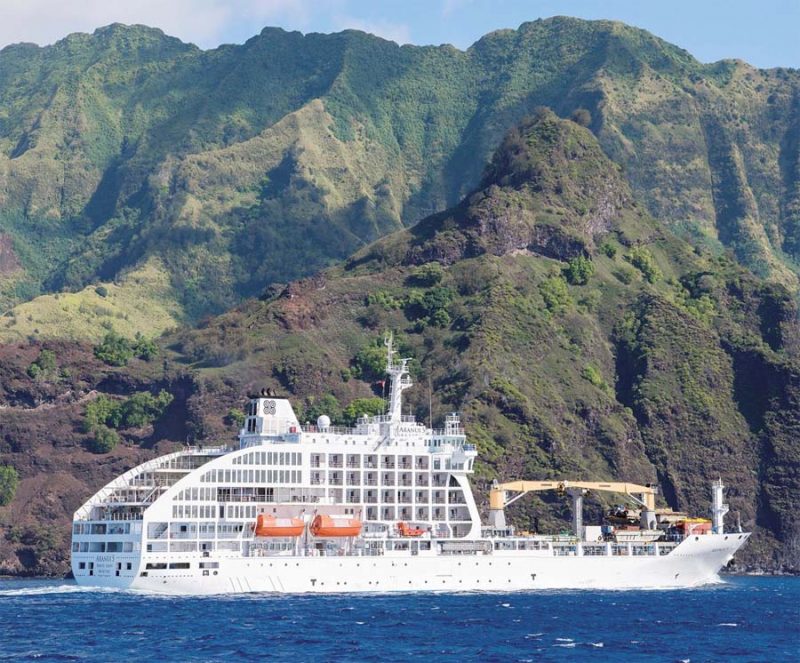
Aranui 3 was a passenger and cargo vessel of 7,325 grt and 3,200 dwt with two cranes to serve her three holds, and a large superstructure aft of eight decks for 208 cabin class passengers. She was completed at the Severnav yard at Severin in Roumania on 24th December 2002 and made the long voyage to the South Pacific to sail on her maiden voyage on 1st March 2003 from Papeete to the Marquesas. She had dimensions of length 383.9 feet, moulded beam of 57.9 feet and draft of 18.1 feet, and a service speed of fifteen knots from a MaK diesel of 5,150 bhp. She made fourteen day voyages to the Marquesas returning via Rangiroa and Fakarava in the Tuamotu Islands until her last voyage ended at Papeete on 4th December 2015.
Aranui 5 is a passenger and cargo vessel of 7,500 grt and 3,300 dwt with two cranes to serve her three holds, and a large sweeping superstructure aft of ten decks for 256 cabin class passengers to replace Aranui 3. She was constructed by the Huanghai Shipbuilding yard at Shandong in China in 2015 and arrived at Papeete for the first time on 9th November 2015. She transports cargo in three holds served by two cranes and passengers to the six ports of Nuku Hiva, Ua Huka, Ua Pou, Hiva Oa, Tahuata and Fatu Hiva in the Marquesas, with return calls at the islands of Rangiroa and Takapoto in the Tuamotu Group before returning via Bora Bora in the Society Islands to Papeete. She has dimensions of length 413.5 feet, moulded beam of 78.9 feet, and draft of 18.1 feet, and a crew of 64 of whom some play in the Aranui Band with Polynesian rhythms to help digest your three course dinners. She has been in service since her maiden voyage of 12th December 2015 to give passengers a cultural experience they will never forget. C.P.T.M. has a Head Office in Papeete, an American office in San Mateo (California), an Australian office in Taylors Lakes (Victoria), and a European office in Paris.
Compagnie Francais Maritime de Tahiti (CFMT) serves the Marquesas and other island groups from Papeete. It was founded in 1890 by Sir James Donald, who had the Pacific contract to supply limes to the Royal Navy, and also owned a large schooner Tiare Taporo of 173 grt, the fastest in all of Polynesia. Small cargo ship traders that carry a few passengers have since been owned including Taporo 374/1949, Taporo II 343/1963, Taporo III 494/1961, Taporo V 299/1969, Taporo VI 497/1977, Taporo VII 2,240/1978, Taporo VIII 1,632/1951 and the current red hulled pallet carrier Taporo IX 2,818/1976.

Moorea and the Windward, Leeward, Tuamotu and Austral Island Groups
Travelling as a deck passenger on the open deck of a South Pacific island trader in warm and sunny weather on a blue ocean is idyllic. The eastern most islands of French Polynesia are remote, with vast expanses of thousands of miles of open ocean to the east, with only Easter Island and Pitcairn Island before reaching South America. The blue anchorages and bays of Moorea are unbelievably beautiful and spectacular for their colour, and can be reached by Aremiti Line fast catamarans. Aremiti 1 began the short history of the company in 1991, followed by Aremiti 2 in 1992, and Aremiti 4 in Millennium year, taking only half an hour to reach their appealing destination. Aremiti 3 built in 1994 carries a maximum of 449 passengers at thirty knots from Papeete on Mondays and Fridays to Huahine and Raiatea in the Leeward Islands and to Moorea on the remaining days, and was the first vessel in the fleet fitted with stabilisers.
Aremiti 5 is an Austal built catamaran that travels at thirty knots between Papeete and Moorea five times daily between 0600 and 1630 hours. She has accommodation for 697 passengers and can also load thirty small cars, but has a larger fleetmate in Aremiti Ferry 2, also an Austal built catamaran with accommodation for 967 passengers and a number of small cars. The population of Moorea is only 15,000 Polynesians but they use the ferries daily to travel to school, work or university. There is competition in the fast catamaran Moorea Express of 449 grt built in 1988 as Oregrund and she has since seen service all over the world including at Macao.
The Leeward islands of Maupiti and Huahine have the twin funnelled blue hulled passenger and cargo ro-ro Hawaiki Nui 879/80 and 1,158 dwt making two calls per week on Tuesdays and Thursdays. Maupiti Tou Aia 1540/67 and 2,420 dwt, the former Aranui and Tuhaa Pae 3, built by J. J. Sietas at Hamburg, makes one voyage per week to Maupiti, Huahine, Raiatea, Tahaa and Bora Bora, leaving Papeete on Mondays, Wednesdays and Fridays. She has accommodation for 50 passengers in 32 cabins, with 3 cranes of 3 tonnes capacity to load via 2 hatches into four holds
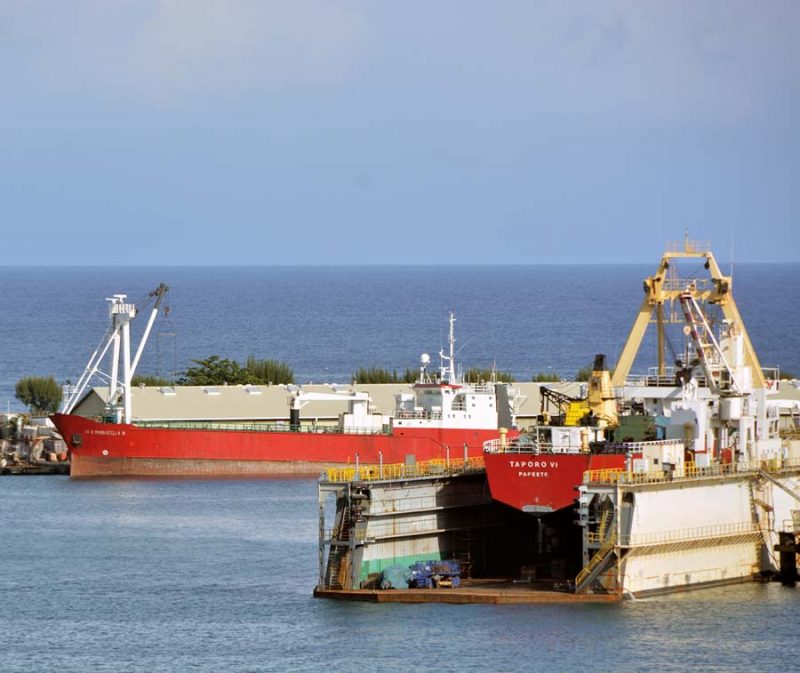
The Tuamotu Islands have the red hulled side loading pallet carrier St. X Maris Stella 1,264/78 and 1,150 dwt serving the island group. She has a bipod mast fitted over her bow and a single heavy lift derrick to deliver heavy equipment to the islands including Mangareva. In 2015 she was joined by the 2,706gt 1985 built St. X Maris-Stella IV. The blue hulled Mareva Nui 400/78 and 900 dwt has two derricks on a single mast ‘midships to handle cargo avierin and out of her single hold, and destined on her once a month voyage to the Gambier Islands.
The Austral Islands are the southern most group of French Polynesia with a population of only 6,300 Polynesians on a land area of 58 square miles on eight main islands plus uninhabited atolls. The white hulled Tuhaa Pae IV 2,346/12 and 1,489 dwt travels three times per month to this isolated southern group of Tubuai, the biggest island, Tuhaa, Maria, Rurutu, Rimatara, Raivavae as well as the southern most Rapa and Marotiri, isolated in their own blue Pacific world. Tuhaa Pae IV is owned by Societe des Navigation des Australes, and has accommodation for 56 cabin class passengers and 44 on open deck seating, with two cranes to handle her cargoes of containers, cement, and steel and house building materials loaded in her single hold, returning with island grown produce. She replaced Tuhaa Pae II of 1,033 grt built at Bordeaux in 1980 with accommodation for 140 passengers and one derrick to load cargo in her single hatch and hold, and was also provided with a stern door/ramp.
Postscript
Life in the paradise of Moorea and Tahiti offers an unhurried way of life with friendly people and their music, songs and dances, which can be glimpsed for a day on a Trans Pacific cruise pulling into the four cruise berths of the Port Autonome de Papeete or Cook’s Bay on Moorea. American writers such as James Michener lived here and wrote his great novel Bali Hai, and artists such as Paul Gauguin found the peace and happiness that had eluded him as a successful stockbroker in Paris. He retreated to a small wooden house on the south coast of Tahiti with his young Polynesian mistress Tehura to live a contented, idyllic life style.
The Port Autonome de Papeete integrates with the fishing, industrial and economic life of Tahiti, with 3,500 people crossing the small bridge near the fishing port to the Mota Uta port area to work there every day. The offices, warehouses and businesses cover 50,000 square metres, and the nearby French Government floating dock can take vessels up to 150.0 metres in length, 17.5 metres in width and with a maximum draft of 5.8 metres. The dock is occupied 60% of the time in the repair of the local French Polynesian traders, and 40% of the time with French Government warship repairs.

The Port Autonome de Papeete worked with the local Chambre de Commerce, banks and commercial businesses in 2009 to provide three quays for deep sea fishing vessels, with full ice making and bait making facilities.
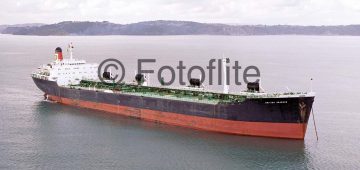



Comments
Sorry, comments are closed for this item